Giacomo Acciarini
Asteroid Mining: ACT&Friends' Results for the GTOC 12 Problem
Oct 28, 2024Abstract:In 2023, the 12th edition of Global Trajectory Competition was organised around the problem referred to as "Sustainable Asteroid Mining". This paper reports the developments that led to the solution proposed by ESA's Advanced Concepts Team. Beyond the fact that the proposed approach failed to rank higher than fourth in the final competition leader-board, several innovative fundamental methodologies were developed which have a broader application. In particular, new methods based on machine learning as well as on manipulating the fundamental laws of astrodynamics were developed and able to fill with remarkable accuracy the gap between full low-thrust trajectories and their representation as impulsive Lambert transfers. A novel technique was devised to formulate the challenge of optimal subset selection from a repository of pre-existing optimal mining trajectories as an integer linear programming problem. Finally, the fundamental problem of searching for single optimal mining trajectories (mining and collecting all resources), albeit ignoring the possibility of having intra-ship collaboration and thus sub-optimal in the case of the GTOC12 problem, was efficiently solved by means of a novel search based on a look-ahead score and thus making sure to select asteroids that had chances to be re-visited later on.
EclipseNETs: a differentiable description of irregular eclipse conditions
Aug 09, 2024Abstract:In the field of spaceflight mechanics and astrodynamics, determining eclipse regions is a frequent and critical challenge. This determination impacts various factors, including the acceleration induced by solar radiation pressure, the spacecraft power input, and its thermal state all of which must be accounted for in various phases of the mission design. This study leverages recent advances in neural image processing to develop fully differentiable models of eclipse regions for highly irregular celestial bodies. By utilizing test cases involving Solar System bodies previously visited by spacecraft, such as 433 Eros, 25143 Itokawa, 67P/Churyumov--Gerasimenko, and 101955 Bennu, we propose and study an implicit neural architecture defining the shape of the eclipse cone based on the Sun's direction. Employing periodic activation functions, we achieve high precision in modeling eclipse conditions. Furthermore, we discuss the potential applications of these differentiable models in spaceflight mechanics computations.
NeuralODEs for VLEO simulations: Introducing thermoNET for Thermosphere Modeling
May 29, 2024Abstract:We introduce a novel neural architecture termed thermoNET, designed to represent thermospheric density in satellite orbital propagation using a reduced amount of differentiable computations. Due to the appearance of a neural network on the right-hand side of the equations of motion, the resulting satellite dynamics is governed by a NeuralODE, a neural Ordinary Differential Equation, characterized by its fully differentiable nature, allowing the derivation of variational equations (hence of the state transition matrix) and facilitating its use in connection to advanced numerical techniques such as Taylor-based numerical propagation and differential algebraic techniques. Efficient training of the network parameters occurs through two distinct approaches. In the first approach, the network undergoes training independently of spacecraft dynamics, engaging in a pure regression task against ground truth models, including JB-08 and NRLMSISE-00. In the second paradigm, network parameters are learned based on observed dynamics, adapting through ODE sensitivities. In both cases, the outcome is a flexible, compact model of the thermosphere density greatly enhancing numerical propagation efficiency while maintaining accuracy in the orbital predictions.
Computing low-thrust transfers in the asteroid belt, a comparison between astrodynamical manipulations and a machine learning approach
May 29, 2024


Abstract:Low-thrust trajectories play a crucial role in optimizing scientific output and cost efficiency in asteroid belt missions. Unlike high-thrust transfers, low-thrust trajectories require solving complex optimal control problems. This complexity grows exponentially with the number of asteroids visited due to orbital mechanics intricacies. In the literature, methods for approximating low-thrust transfers without full optimization have been proposed, including analytical and machine learning techniques. In this work, we propose new analytical approximations and compare their accuracy and performance to machine learning methods. While analytical approximations leverage orbit theory to estimate trajectory costs, machine learning employs a more black-box approach, utilizing neural networks to predict optimal transfers based on various attributes. We build a dataset of about 3 million transfers, found by solving the time and fuel optimal control problems, for different time of flights, which we also release open-source. Comparison between the two methods on this database reveals the superiority of machine learning, especially for longer transfers. Despite challenges such as multi revolution transfers, both approaches maintain accuracy within a few percent in the final mass errors, on a database of trajectories involving numerous asteroids. This work contributes to the efficient exploration of mission opportunities in the asteroid belt, providing insights into the strengths and limitations of different approximation strategies.
Closing the Gap Between SGP4 and High-Precision Propagation via Differentiable Programming
Feb 26, 2024

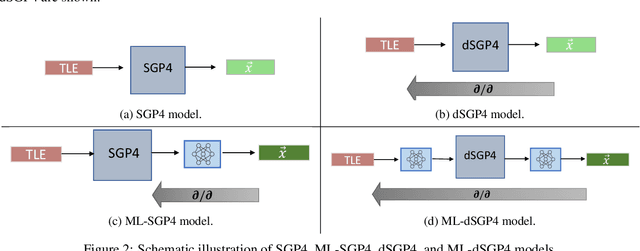
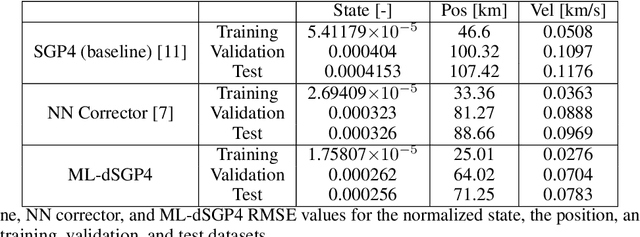
Abstract:The Simplified General Perturbations 4 (SGP4) orbital propagation method is widely used for predicting the positions and velocities of Earth-orbiting objects rapidly and reliably. Despite continuous refinement, SGP models still lack the precision of numerical propagators, which offer significantly smaller errors. This study presents dSGP4, a novel differentiable version of SGP4 implemented using PyTorch. By making SGP4 differentiable, dSGP4 facilitates various space-related applications, including spacecraft orbit determination, state conversion, covariance transformation, state transition matrix computation, and covariance propagation. Additionally, dSGP4's PyTorch implementation allows for embarrassingly parallel orbital propagation across batches of Two-Line Element Sets (TLEs), leveraging the computational power of CPUs, GPUs, and advanced hardware for distributed prediction of satellite positions at future times. Furthermore, dSGP4's differentiability enables integration with modern machine learning techniques. Thus, we propose a novel orbital propagation paradigm, ML-dSGP4, where neural networks are integrated into the orbital propagator. Through stochastic gradient descent, this combined model's inputs, outputs, and parameters can be iteratively refined, surpassing SGP4's precision. Neural networks act as identity operators by default, adhering to SGP4's behavior. However, dSGP4's differentiability allows fine-tuning with ephemeris data, enhancing precision while maintaining computational speed. This empowers satellite operators and researchers to train the model using specific ephemeris or high-precision numerical propagation data, significantly advancing orbital prediction capabilities.
The Fellowship of the Dyson Ring: ACT&Friends' Results and Methods for GTOC 11
May 23, 2022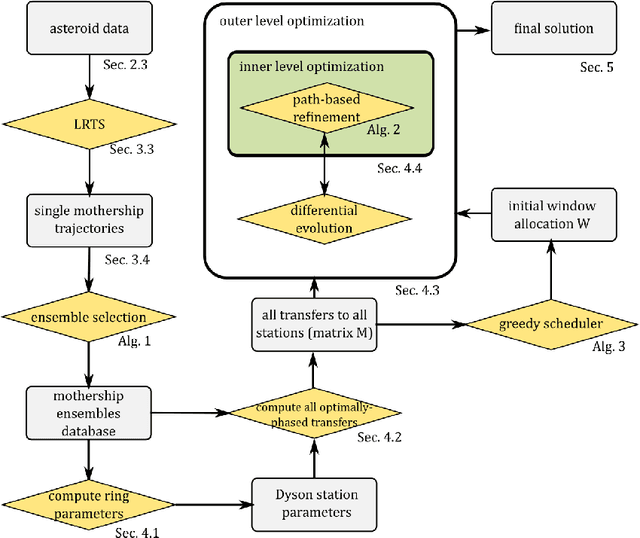
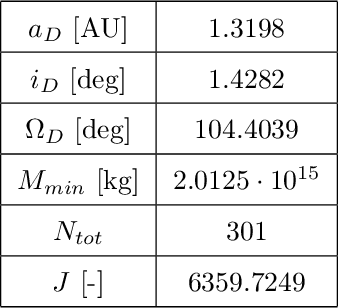
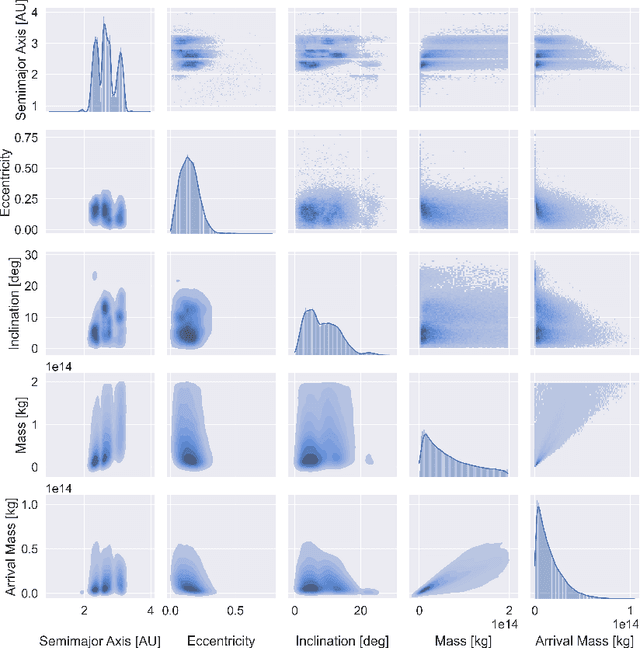
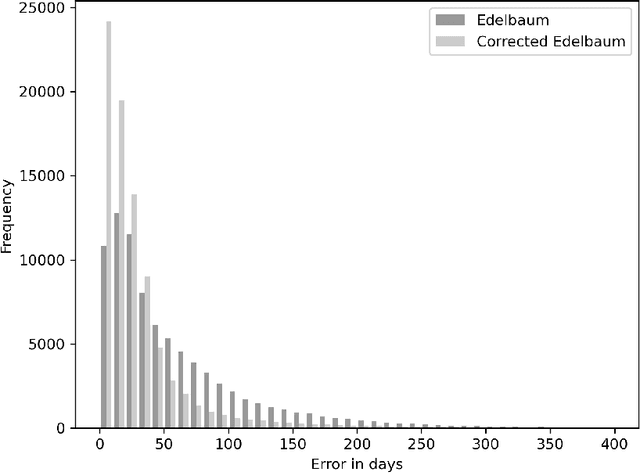
Abstract:Dyson spheres are hypothetical megastructures encircling stars in order to harvest most of their energy output. During the 11th edition of the GTOC challenge, participants were tasked with a complex trajectory planning related to the construction of a precursor Dyson structure, a heliocentric ring made of twelve stations. To this purpose, we developed several new approaches that synthesize techniques from machine learning, combinatorial optimization, planning and scheduling, and evolutionary optimization effectively integrated into a fully automated pipeline. These include a machine learned transfer time estimator, improving the established Edelbaum approximation and thus better informing a Lazy Race Tree Search to identify and collect asteroids with high arrival mass for the stations; a series of optimally-phased low-thrust transfers to all stations computed by indirect optimization techniques, exploiting the synodic periodicity of the system; and a modified Hungarian scheduling algorithm, which utilizes evolutionary techniques to arrange a mass-balanced arrival schedule out of all transfer possibilities. We describe the steps of our pipeline in detail with a special focus on how our approaches mutually benefit from each other. Lastly, we outline and analyze the final solution of our team, ACT&Friends, which ranked second at the GTOC 11 challenge.
Simultaneous Multivariate Forecast of Space Weather Indices using Deep Neural Network Ensembles
Dec 16, 2021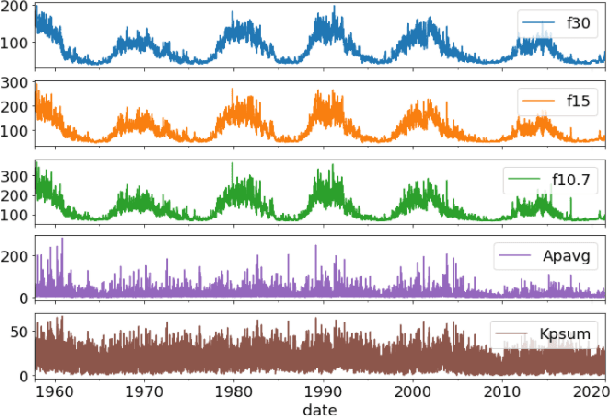
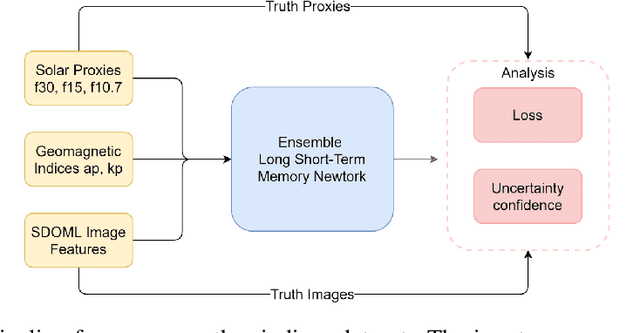
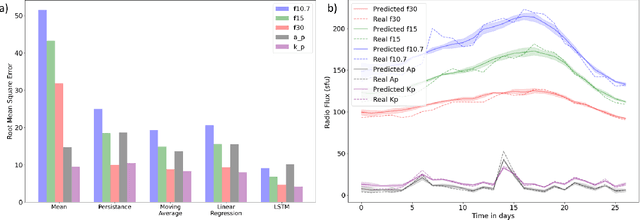
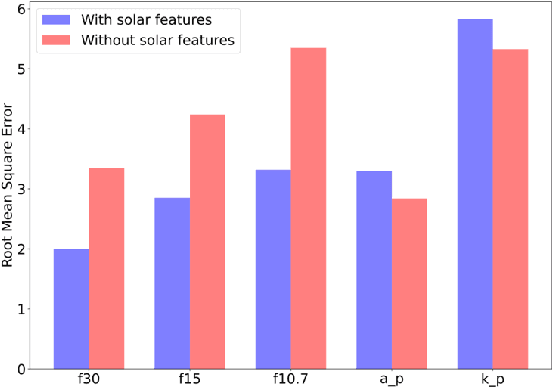
Abstract:Solar radio flux along with geomagnetic indices are important indicators of solar activity and its effects. Extreme solar events such as flares and geomagnetic storms can negatively affect the space environment including satellites in low-Earth orbit. Therefore, forecasting these space weather indices is of great importance in space operations and science. In this study, we propose a model based on long short-term memory neural networks to learn the distribution of time series data with the capability to provide a simultaneous multivariate 27-day forecast of the space weather indices using time series as well as solar image data. We show a 30-40\% improvement of the root mean-square error while including solar image data with time series data compared to using time series data alone. Simple baselines such as a persistence and running average forecasts are also compared with the trained deep neural network models. We also quantify the uncertainty in our prediction using a model ensemble.
Towards Automated Satellite Conjunction Management with Bayesian Deep Learning
Dec 23, 2020

Abstract:After decades of space travel, low Earth orbit is a junkyard of discarded rocket bodies, dead satellites, and millions of pieces of debris from collisions and explosions. Objects in high enough altitudes do not re-enter and burn up in the atmosphere, but stay in orbit around Earth for a long time. With a speed of 28,000 km/h, collisions in these orbits can generate fragments and potentially trigger a cascade of more collisions known as the Kessler syndrome. This could pose a planetary challenge, because the phenomenon could escalate to the point of hindering future space operations and damaging satellite infrastructure critical for space and Earth science applications. As commercial entities place mega-constellations of satellites in orbit, the burden on operators conducting collision avoidance manoeuvres will increase. For this reason, development of automated tools that predict potential collision events (conjunctions) is critical. We introduce a Bayesian deep learning approach to this problem, and develop recurrent neural network architectures (LSTMs) that work with time series of conjunction data messages (CDMs), a standard data format used by the space community. We show that our method can be used to model all CDM features simultaneously, including the time of arrival of future CDMs, providing predictions of conjunction event evolution with associated uncertainties.
Spacecraft Collision Risk Assessment with Probabilistic Programming
Dec 18, 2020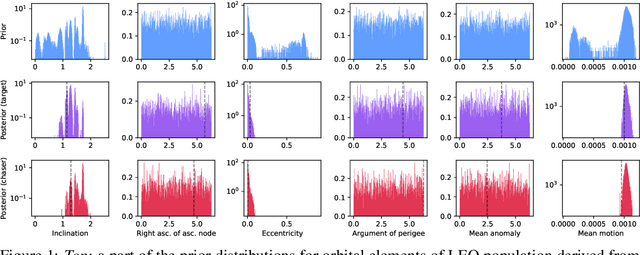

Abstract:Over 34,000 objects bigger than 10 cm in length are known to orbit Earth. Among them, only a small percentage are active satellites, while the rest of the population is made of dead satellites, rocket bodies, and debris that pose a collision threat to operational spacecraft. Furthermore, the predicted growth of the space sector and the planned launch of megaconstellations will add even more complexity, therefore causing the collision risk and the burden on space operators to increase. Managing this complex framework with internationally agreed methods is pivotal and urgent. In this context, we build a novel physics-based probabilistic generative model for synthetically generating conjunction data messages, calibrated using real data. By conditioning on observations, we use the model to obtain posterior distributions via Bayesian inference. We show that the probabilistic programming approach to conjunction assessment can help in making predictions and in finding the parameters that explain the observed data in conjunction data messages, thus shedding more light on key variables and orbital characteristics that more likely lead to conjunction events. Moreover, our technique enables the generation of physically accurate synthetic datasets of collisions, answering a fundamental need of the space and machine learning communities working in this area.
 Add to Chrome
Add to Chrome Add to Firefox
Add to Firefox Add to Edge
Add to Edge